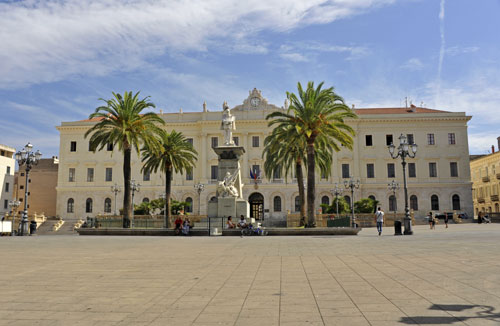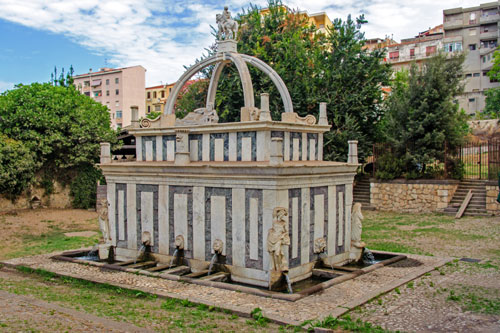Sassari and Noeddale Necropolis
map of Sassari and Noeddale with marked points of interest
Sassari
 The capital of the province of the same name is – after Cagliari – the second-largest city in Sardinia.
The capital of the province of the same name is – after Cagliari – the second-largest city in Sardinia.
Sassari was built by former inhabitants of the city of Turris Lybissonis (today Porto Torres), who relocated inland due to frequent pirate attacks.
After Sardinia became part of the new state of Italy, the fortifications were demolished, and the new town of Sassari was built.
The Piazza d’Italia (photo) is the center of the old town. Here stands a monument to King Vittorio Emanuele II.
The square is a popular meeting place for the inhabitants of Sassari. It gets particularly crowded on balmy summer evenings.
In May, the city hosts the “Cavalcata Sarda” – one of the largest festivals in Sardinia.
On August 14th, during the annual “Festa dei Candelieri,” giant candles are carried through the city. Since this festival falls in the middle of the tourist season, the city center becomes extremely crowded.

The old town of Sassari is architecturally distinct from the new town.
A walk through the historic part is very interesting.
The main promenade and shopping street, Corso Vittorio Emanuele II (photo), runs through the center.
Beautiful old townhouses and palazzi line both sides, housing small shops on the lower floors.
North of the Corso are several squares where markets are often held, as well as a large, modern market hall for fish, meat, fruits, and vegetables.
It is very difficult to find parking near the old town. Many parking spaces require a fee or are only for use while shopping at nearby stores.
My tip: there is a shopping center with a relatively inexpensive parking garage on Via Michele Coppino. (see map)
Piazza Castello
 The square is at the upper end of Corso Vittorio Emanuele II.
The square is at the upper end of Corso Vittorio Emanuele II.
Originally, the Aragonese castle that gave the square its name stood here.
The fortress lost its military function as early as the 16th century and then became the seat of the Inquisition.
In 1877, the fortress was demolished, and the square was gradually redesigned.
On the north side stands the Lamarmora barracks, which has housed the Brigata Sassari Museum since 1992.
Remains of the old castle can be seen under glass on the west side of the Piazza.
San Nicola Cathedral
 The church is named after Saint Nicholas of Bari.
The church is named after Saint Nicholas of Bari.
Of the original Romanesque church from the 13th century, only the bell tower remains.
In the 15th century, the church was remodeled in the Catalan Gothic style, and in the early 18th century, the Baroque facade was added.
In contrast to the splendid facade, the rest of the exterior walls are relatively plain.
A statue of the patron saint stands high above the entrance, flanked by two angels, with God watching over them, holding the globe.
Inside, the Gothic style prevails, with a beautiful marble altar and magnificent side altars.
Palazzo Ducale

The palace is located directly behind the cathedral.
It was built between 1775 and 1805 on the orders of Don Antonio Manca Amat, who died before its completion.
His nephew, Don Vincenzo Manca Amat, was the first to reside here.
The palace was later inhabited by various private individuals, served as the seat of the provincial administration, and has been the town hall since 1878.
The facade consists of limestone and was still unfinished when the city bought the building. The balcony above the entrance was added in 1908.
Fontana di Rosello
 The fountain is quite hidden below the Ponte di Rosello road bridge.
The fountain is quite hidden below the Ponte di Rosello road bridge.
Opposite the market hall, a staircase leads down from the bridge on the left.
The Gurusellu spring here fed the Roman aqueduct that brought water to Turris (Porto Torres) to supply the local baths.
The current marble fountain house was built by Genoese builders from 1603-1606.
At the corners are four statues symbolizing the seasons, and water flows from twelve mouths representing the flow of time.
During the uprisings against the feudal system in 1795, three of the statues were destroyed. In 1828, all four figures were replaced, and the only original now resides in the Ducal Palace, the town hall.
City Wall Remains

When you go up the stairs from the fountain, it is worth visiting the modern market hall of Sassari. In the fully air-conditioned hall, meat, fish, seafood, fruits, and vegetables are offered at numerous stands.
On Corso Trinità, you will come across several remnants of the old city wall. Some of these remnants have been “integrated” into later new buildings.
The fortification from the 13th century was originally 2 km long, had four gates, and 36 towers.
From the mid-19th century, the demolition of the structure began.
Further wall remains can be found on Via Torre Tonda in the south of the old town.
The only fully preserved tower of the former fortifications is the Torre Sant’ Antonio at the corner of Corso Francesco Vico – Piazza Sant’ Antonio. (see map)
Museo G. A. Sanna

The museum is one of the most important archaeological museums in Sardinia.
Mainly finds recovered during excavations and numerous private donations are exhibited.
The exhibits span from the Stone Age to the Middle Ages.
One hall is entirely dedicated to the sanctuary on Monte d’Accoddi. Other rooms show finds and reconstructions from the time of the Nuraghi, the Phoenicians, Roman Turris Lybissonis (Porto Torres), and the Spanish-influenced period of the island.
The collection originated in 1878 from the donation of Giovanni Antonio Sanna’s archaeological collection and has been extensively expanded in the following decades.
Since 1931, the museum has been housed in this building, which was later remodeled and opened in its current form in 1973.
Santa Maria di Betlem
 This church is located near the train station and is one of the oldest in the city.
This church is located near the train station and is one of the oldest in the city.
It was originally built in the 12th century for a Benedictine monastery, which was taken over by the Franciscans in the 13th century.
The Romanesque facade and the Pisan portal are almost original.
The interior of the church is very richly and magnificently decorated in the Baroque style.
Here, the giant wooden candles weighing up to 300 kg for the annual “Festa dei Candelieri” are also kept.
Noeddale Necropolis

If you are in the Sassari area, a side trip to Ossi is worthwhile.
The municipality is easily accessible from the SS131.
In its vicinity are several necropolises with rock tombs – so-called “Domus de Janas” (fairy houses).
The most famous site is the Necropolis of Noeddale from the 4th-3rd millennium BC.
There are several chambers here, each designed differently.
In the “Tomba della Casa,” the ceiling imitates a hut (similar to Sant’ Andria Priu).
Stylized ridge and cross beams and suggested stones were carved out. (photo) This tomb alone consists of a total of 11 rooms.

